Welcome to September's issue of the Dereila Nature Inn newsletter.
As we move in to the autumn season when mushrooms are so plentiful, you are welcomed this month by a rather unusual one: Arched Earthstar, Geastium fornicatum. |
Greetings
~~~~~~~~~~~~~~~~~~~~~~~~~~~~~~~~~~~~~~~~~~~~~~~~~~~~~~~
Hi everyone and welcome to the latest edition of Whispers, the newsletter of the Dereila Nature Inn - your virtual nature centre. We hope you've had a most enjoyable summer and were able to get out and about and enjoy nature wherever you live and wherever your travels may have taken you.
In this month's issue we have some wonderful photos that people have sent in for us all to enjoy, plus some tips and ideas as well as some trivia and news about the latest additions at the Inn.
Many thanks for subscribing and a warm welcome to our new subscribers!
 Please join us on Facebook where we welcome your comments and feedback. |
|
Trivia Time
~~~~~~~~~~~~~~~~~~~~~~~~~~~~~~~~~~~~~~~~~~~~~~~~~~~~~~~
Which tree is considered to be the most colourful tree on Earth?
You'll find the answer at the end of the newsletter. |
What's This? ~~~~~~~~~~~~~~~~~~~~~~~~~~~~~~~~~~~~~~~~~~~~~~~~~~~~~~~
Do you know what this cropped close-up photograph is?
We have another easy one this month!
For more of this type of mystery solving,
|
| New Features at the Inn
~~~~~~~~~~~~~~~~~~~~~~~~~~~~~~~~~~~~~~~~~~~~~~~~~~~~~~~
Here are the latest additions at the Inn. Just click on the images and you'll be taken straight to the page.
Parts of a Flower
This page explains some of the different terminology used when discussing parts of a flower.
Bugs Trivia 1 - Dragonflies
Learn all about dragonflies and damselflies on this page of trivia and interesting facts.
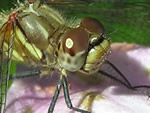
Bugs Trivia 2 - Butterflies
You'll find all kinds of interesting facts about beautiful butterflies on this new page.
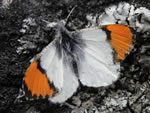 |
|
Contributed by...
~~~~~~~~~~~~~~~~~~~~~~~~~~~~~~~~~~~~~~~~~~~~~~~~~~~~~~
We know you're going to really enjoy this month's amazing
selection of nature photographs that have been submitted.
This Red-bellied Woodpecker was sent in by Gail Freiherr, Knoxville, Tennessee. Bernadette Herron of Townsville, Queensland, Australia, sent us another wonderful picture from Down Under of two Agile Wallabies, Macrupus agilis. 
Claudia Gregoire, Glenville, New York, captured this heron in
a rather dramatic and unusual pose.
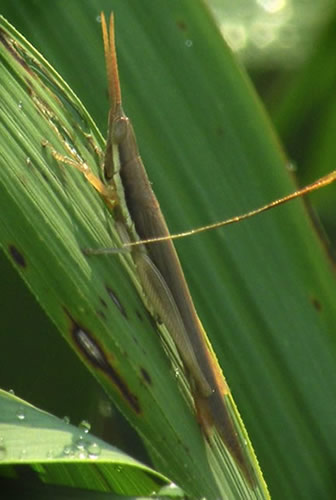 This very strange insect is a Longheaded Toothpick Grasshopper, Achurum carinatum. It's another great shot sent in by Debbie Smith, Summerville, South Carolina.

Rosemary O'Connell, Ottawa, Ontario, spotted this pretty
female Red-winged Blackbird near the Rideau River in Ottawa.
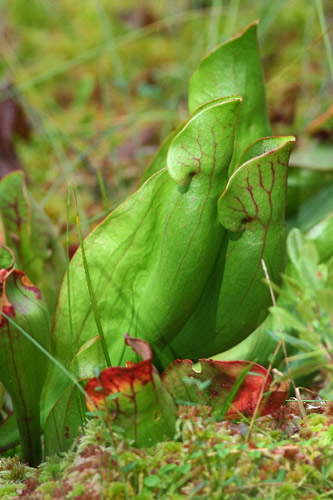
Frank and Sandra Horvath, Grimsby, Ontario, sent in
this fantastic photograph of a Northern Pitcher-plant.
Many thanks to Gail, Bernadette, Claudia, Debbie, Rosemary, Frank and Sandra for taking the time to send in these wonderful photographs. We really appreciate it!
If you would like to see your nature images in our members' section,
simply send us an e-mail. We'd love to hear from you. |
| Monthly Selections
~~~~~~~~~~~~~~~~~~~~~~~~~~~~~~~~~~~~~~~~~~~~~~~~~~~~~~
Here are this month's choices: Bug - Pacific Spiketail; Wildflower - Fernleaf Biscuitroot; Bird - White-winged Dove 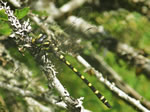 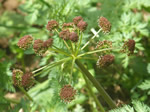 
Simply click on the images to visit the pages.
You can also check out the archives as they're just a click away:
Wildflower Archives | Bug Archives | Bird Archives
OUR MONTHLY PAGE
If you like bugs, you'll enjoy this month's highlighted page: The Bug World: Insects and Spiders. It is the starting page where you will find links to over two dozen pages about all kinds of bugs including butterflies, dragonflies, bees and spiders.
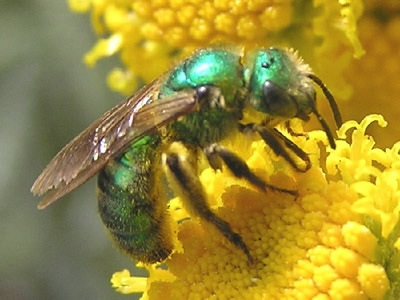
|
| The Wandering Image
~~~~~~~~~~~~~~~~~~~~~~~~~~~~~~~~~~~~~~~~~~~~~~~~~~~~~~
This month we wander into a meadow of wildflowers.  A brilliant Monarch Butterfly feeds on a flower in the sunshine.
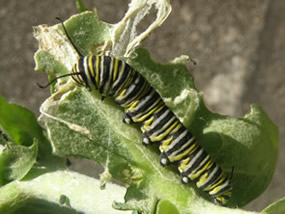 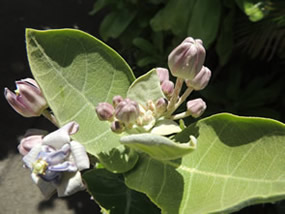
The main food source of the Monarch Butterfly larvae (left) is Milkweed. |
| Caption This!
~~~~~~~~~~~~~~~~~~~~~~~~~~~~~~~~~~~~~~~~~~~~~~~~~~~~~~~
What do you think would be a good caption for this photo?
As usual, we've given you a couple of ideas.
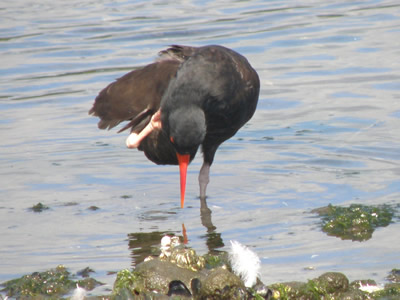
Number one: "Now, let me see. Where have I seen this guy before?"
Number two: "Don't take the picture yet! I'll say when."
If this month's photo inspires you, please send us an e-mail. We'd love to hear from you and add your caption to our collection. You can visit the rest of the collections at the Inn: The Mammals| The Birds | The Insects |
|
Snippets in Nature
~~~~~~~~~~~~~~~~~~~~~~~~~~~~~~~~~~~~~~~~~~~~~~~~~~~~~~

This rugged wilderness area is called Garden of the Gods and is
located in southern Illinois. It is a place of fascinating and unusual
rock formations like this one which is called Devil's Smokestack.
Special thanks to Jim Noeninger for sending this in to us.
If you think you have a suitable nature photograph for this section please send us an e-mail along with a brief explanation. We look forward to your submissions. |
Behind the Name
~~~~~~~~~~~~~~~~~~~~~~~~~~~~~~~~~~~~~~~~~~~~~~~~~~~~~~~
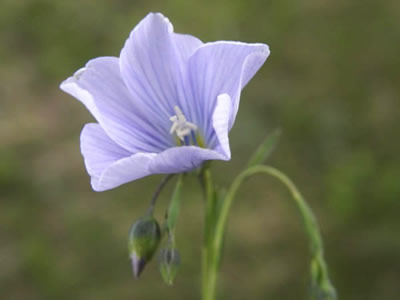
Blue Flax, Linum perenne, is a delicate plant with a flower that moves even in the slightest breeze. The genus name, Linum, comes from the Greek word linon, which means "thread." |
Joke of the Month ~~~~~~~~~~~~~~~~~~~~~~~~~~~~~~~~~~~~~~~~~~~~~~~~~~~~~~~
Two ground squirrels were resting in their den when the phone rang. Mr. Ground Squirrel asked his wife to answer it.
After a few seconds his wife said, "How would I know? The sea is 400 miles away." and hung up.
"Who was that?" asked her husband.
"Some crazy lady who wanted to know if the coast was clear!"
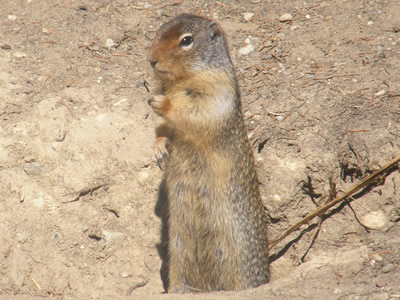
"I told her not to phone here." |
| Notes, News and Tips from Around the Inn
~~~~~~~~~~~~~~~~~~~~~~~~~~~~~~~~~~~~~~~~~~~~~~~~~~~~~~~
Facebook
 We invite you to post comments on our Facebook page. To visit, just click on the logo or here.
A Little Reminder
It's time already to start to collect a few berries - but not for you!
Pop them in the freezer and when the bad weather of winter arrives and it's hard for birds to find any berries you can put them out on your feeding station. Your winged visitors will be truly thankful for this winter feed.
Tips from the Inn
Many insects are easy to photograph but some are really difficult,
like the busy bees. With a little planning and patience however,
the problem can be solved.
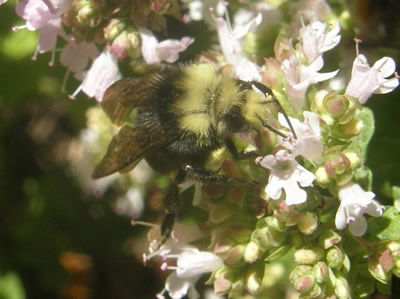 When bees are buzzing around a bunch of flowers, focus on a section where you think the bee might go next. When the top photo was taken, it seemed quite obvious that the bee would come around to the front. Being ready can provide great dividends as shown in the bottom picture. Picture of the Week  Be sure to drop by the Inn every week to see the latest Picture of the Week. You can also do so by clicking on the image to the left or by clicking here.
Past Issues
We upload past issues of Whispers as new ones are issued. You can view them all with a simple click here.
|
|
Celebrating Nature
~~~~~~~~~~~~~~~~~~~~~~~~~~~~~~~~~~~~~~~~~~~~~~~~~~~~~~~~
Here are some of the celebrations of nature that are coming up.
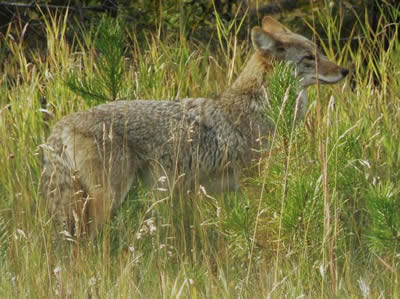
National Wildlife Day is celebrated on September 4th
Click here for more information.
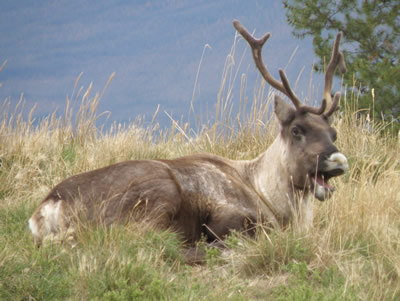
World Animal Day happens around the planet on October 4.
This a day to recognize the important role that animals play
in our lives and how much our lives are enriched by animals.
Click here for details.

National Wildlife Refuge Week is happening October 13-19 and
we'll have more information about that next month. |
Did You Know...
~~~~~~~~~~~~~~~~~~~~~~~~~~~~~~~~~~~~~~~~~~~~~~~~~~~~~~~~
Did you know deer lose their antlers and grow new ones every year? When the growing antlers have received enough vitamins and minerals the flow of blood to the antlers is cut off at the base. The velvet on the newly-formed antlers dries up and gets itchy, so deer may rub up against trees to get it off. Sometimes however, the antlers bleed because the blood may not be fully cut off. |
| Emblems and Symbols of the World
~~~~~~~~~~~~~~~~~~~~~~~~~~~~~~~~~~~~~~~~~~~~~~~~~~~~~~~~
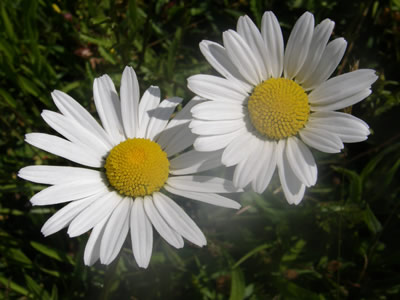
The Baltic state of Latvia has selected the Oxeye Daisy,
Leucanthemum vulgare, as its state flower. |
|
Trivia Answer
~~~~~~~~~~~~~~~~~~~~~~~~~~~~~~~~~~~~~~~~~~~~~~~~~~~~~~~~

Many people consider the Rainbow-bark Eucalyptus,
Eucalyptus deglupta, to be the most colourful tree on the planet. |
| What's This?
~~~~~~~~~~~~~~~~~~~~~~~~~~~~~~~~~~~~~~~~~~~~~~~~~~~~~~~~

This month's mystery photo a very clean but very wet female Northern Flicker. |
| Nature Notes
~~~~~~~~~~~~~~~~~~~~~~~~~~~~~~~~~~~~~~~~~~~~~~~~~~~~~~~~

|
|
Spread the Word ~~~~~~~~~~~~~~~~~~~~~~~~~~~~~~~~~~~~~~~~~~~~~~~~~~~~~~~~~
We hope you've enjoyed our newsletter for this month and that you'll forward it on to your nature-loving friends. Until next time may you enjoy many wonderful encounters of nature.
We hope you'll watch for the next issue of Whispers in your inbox during the first week of October. See you then! |
|